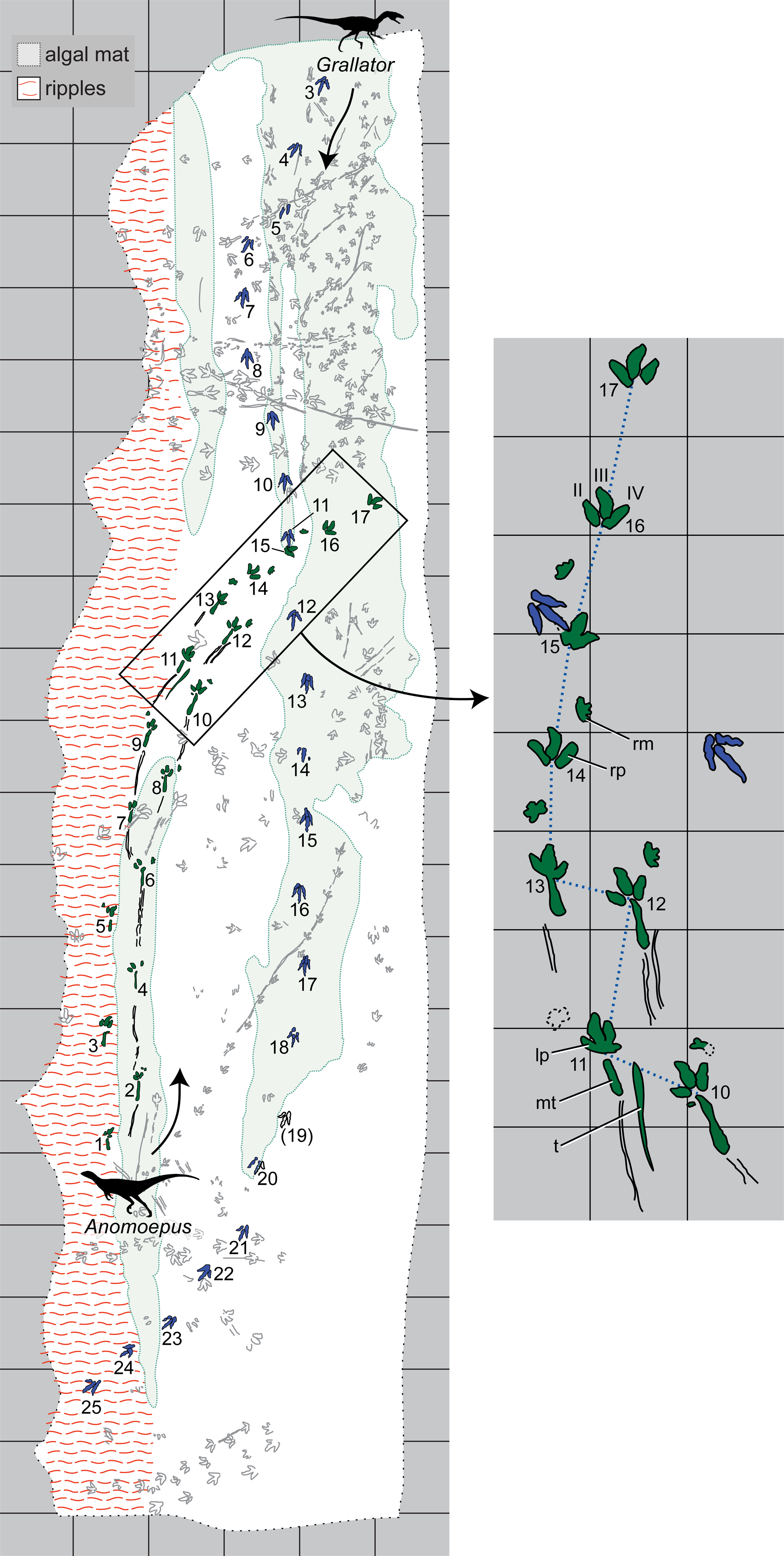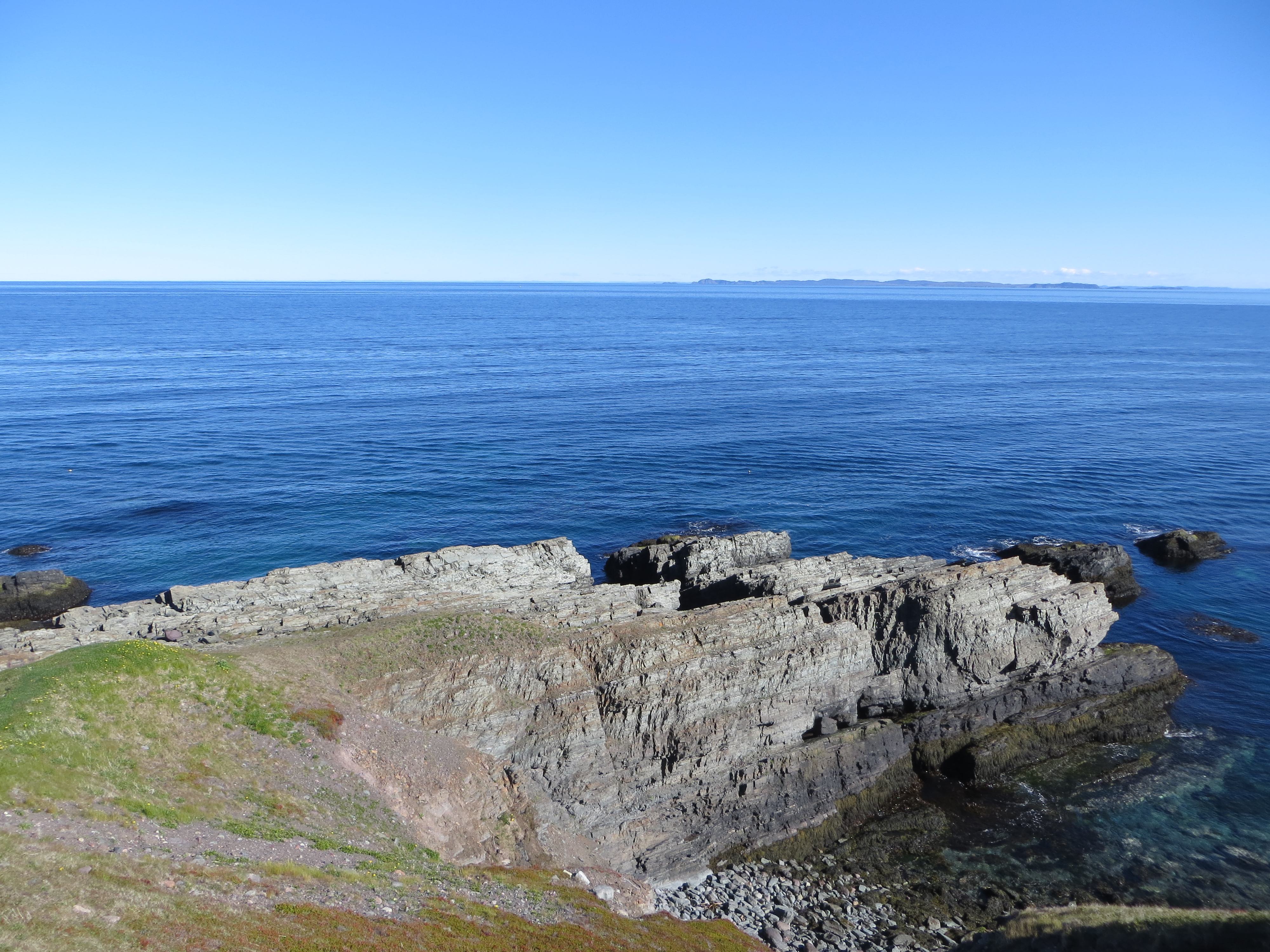 |
Ichnology
A trace fossil, also called an ichnofossil (; ), is a fossil record of biological activity by lifeforms, but not the preserved remains of the organism itself. Trace fossils contrast with body fossils, which are the fossilized remains of parts of organisms' bodies, usually altered by later chemical activity or by mineralization. The study of such trace fossils is ichnology - the work of ichnologists. Trace fossils may consist of physical impressions made on or in the substrate by an organism. For example, burrows, borings ( bioerosion), urolites (erosion caused by evacuation of liquid wastes), footprints, feeding marks, and root cavities may all be trace fossils. The term in its broadest sense also includes the remains of other organic material produced by an organism; for example coprolites (fossilized droppings) or chemical markers (sedimentological structures produced by biological means; for example, the formation of stromatolites). However, most sedimentary structure ... [...More Info...] [...Related Items...] OR: [Wikipedia] [Google] [Baidu] |
|
Trace Fossil Classification
Trace fossils are classified in various ways for different purposes. Traces can be classified taxonomically (by morphology), ethologically (by behavior), and toponomically, that is, according to their relationship to the surrounding sedimentary layers. Except in the rare cases where the original maker of a trace fossil can be identified with confidence, phylogenetic classification of trace fossils is an unreasonable proposition. Taxonomic classification The taxonomic classification of trace fossils parallels the taxonomic classification of organisms under the International Code of Zoological Nomenclature. In trace fossil nomenclature a Latin binomial name is used, just as in animal and plant taxonomy, with a genus and specific epithet. However, the binomial names are not linked to an organism, but rather just a trace fossil. This is due to the rarity of association between a trace fossil and a specific organism or group of organisms. Trace fossils are therefore included in an ... [...More Info...] [...Related Items...] OR: [Wikipedia] [Google] [Baidu] |
|
 |
Ichnite
A fossil track or ichnite (Greek "''ιχνιον''" (''ichnion'') – a track, trace or footstep) is a fossilized footprint. This is a type of trace fossil. A fossil trackway is a sequence of fossil tracks left by a single organism. Over the years, many ichnites have been found, around the world, giving important clues about the behaviour (and foot structure and stride) of the animals that made them. For instance, multiple ichnites of a single species, close together, suggest 'herd' or 'pack' behaviour of that species. Combinations of footprints of different species provide clues about the interactions of those species. Even a set of footprints of a single animal gives important clues, as to whether it was bipedal or quadrupedal. In this way, it has been suggested that some pterosaurs, when on the ground, used their forelimbs in an unexpected quadrupedal action. Special conditions are required, in order to preserve a footprint made in soft ground (such as an alluvial plain or a ... [...More Info...] [...Related Items...] OR: [Wikipedia] [Google] [Baidu] |
 |
Anomoepus
''Anomoepus'' is the name assigned to several fossil footprints first reported from Early Jurassic beds of the Connecticut River Valley, Massachusetts, US in 1802. All four feet have left impressions. The smaller forefeet have five toes, whereas the larger hind feet have three toes. There is also an impression which might indicate where the creature rested. The footprints were discovered, amongst others, by a farm boy, Pliny Moody. E.B. Hitchcock, a clergyman, described the ''Anomoepus'' footprints and others as evidence of ancient birds. They have since been identified as belonging to a dinosaur, probably an ornithischian, as indicated by the number of toes and the absence of claws on the rear digits. Trackways assigned to ''Anomoepus'' from Western Australia, Poland and Czech Republic have also been described. ''Anomoepus'' is the name of the footprint, not of the dinosaur, the identity of which remains unknown. Ichnospecies *'' A. scambus'' Hitchcock, 1848 *'' A. ranivorus ... [...More Info...] [...Related Items...] OR: [Wikipedia] [Google] [Baidu] |
|
Atreipus
''Atreipus'' is an ichnogenus or trace fossil attributed to early Ornithischian dinosaurs. Its significance for Triassic biostratigraphy has earned it some fame. Reptile footprint faunules from the early Mesozoic Newark Supergroup of eastern North America. See also * Ichnology A trace fossil, also called an ichnofossil (; ), is a fossil record of biological activity by lifeforms, but not the preserved remains of the organism itself. Trace fossils contrast with body fossils, which are the fossilized remains of part ... References {{trace-fossil-stub Ichnotaxa ... [...More Info...] [...Related Items...] OR: [Wikipedia] [Google] [Baidu] |
|
 |
Grallator
''Grallator'' () is an ichnogenus (form taxon based on footprints) which covers a common type of small, three-toed print made by a variety of bipedal theropod dinosaurs. ''Grallator''-type footprints have been found in formations dating from the Early Triassic through to the early Cretaceous periods. They are found in the United States, Canada, Europe, India, Australia, Brazil ( Sousa and Santa Maria Formations) and China,''Grallator'' at .org but are most abundant on the east coast of North America, especially the and |
|
Cheirotherium Prints Possibly Ticinosuchus
''Chirotherium'', also known as ''Cheirotherium'' (‘hand-beast’), is a Triassic trace fossil consisting of five-fingered (pentadactyle) footprints and whole tracks. These look, by coincidence, remarkably like the hands of apes and bears, with the outermost toe having evolved to extend out to the side like a thumb, although probably only functioning to provide a firmer grip in mud. ''Chirotherium'' tracks were first found in 1834 in Lower Triassic sandstone (Buntsandstein) in Thuringia, Germany, dating from about 243 million years ago (mya (unit), mya). The creatures who made the footprints and tracks were probably pseudosuchian archosaurs related to the ancestors of the crocodiles. They likely belonged to either prestosuchidae or rauisuchidae groups, which were both large carnivores with semi-erect gaits. History ''Chirotherium'' tracks were first found in German Triassic sandstones in 1834, and later in England in 1838. They were found before dinosaurs were known and init ... [...More Info...] [...Related Items...] OR: [Wikipedia] [Google] [Baidu] |
|
 |
Ethology
Ethology is a branch of zoology that studies the behavior, behaviour of non-human animals. It has its scientific roots in the work of Charles Darwin and of American and German ornithology, ornithologists of the late 19th and early 20th century, including Charles Otis Whitman, Charles O. Whitman, Oskar Heinroth, and Wallace Craig. The modern discipline of ethology is generally considered to have begun during the 1930s with the work of the Dutch biologist Nikolaas Tinbergen and the Austrian biologists Konrad Lorenz and Karl von Frisch, the three winners of the 1973 Nobel Prize in Physiology or Medicine. Ethology combines laboratory and field science, with a strong relation to neuroanatomy, ecology, and evolutionary biology. Etymology The modern term ''ethology'' derives from the Greek language: wikt:ἦθος, ἦθος, ''ethos'' meaning "character" and , ''wikt:-logia, -logia'' meaning "the study of". The term was first popularized by the American entomologist William Mo ... [...More Info...] [...Related Items...] OR: [Wikipedia] [Google] [Baidu] |
 |
Holocene
The Holocene () is the current geologic time scale, geological epoch, beginning approximately 11,700 years ago. It follows the Last Glacial Period, which concluded with the Holocene glacial retreat. The Holocene and the preceding Pleistocene together form the Quaternary period. The Holocene is an interglacial period within the ongoing Ice age, glacial cycles of the Quaternary, and is equivalent to Marine isotope stages, Marine Isotope Stage 1. The Holocene correlates with the last maximum axial tilt towards the Sun of the Earth#Axial tilt and seasons, Earth's obliquity. The Holocene corresponds with the rapid proliferation, growth, and impacts of the human species worldwide, including Recorded history, all of its written history, technological revolutions, development of major civilizations, and overall significant transition towards urban culture, urban living in the present. The human impact on modern-era Earth and its ecosystems may be considered of global significance for th ... [...More Info...] [...Related Items...] OR: [Wikipedia] [Google] [Baidu] |
 |
Triassic
The Triassic ( ; sometimes symbolized 🝈) is a geologic period and system which spans 50.5 million years from the end of the Permian Period 251.902 million years ago ( Mya), to the beginning of the Jurassic Period 201.4 Mya. The Triassic is the first and shortest period of the Mesozoic Era and the seventh period of the Phanerozoic Eon. Both the start and end of the period are marked by major extinction events. The Triassic Period is subdivided into three epochs: Early Triassic, Middle Triassic and Late Triassic. The Triassic began in the wake of the Permian–Triassic extinction event, which left the Earth's biosphere impoverished; it was well into the middle of the Triassic before life recovered its former diversity. Three categories of organisms can be distinguished in the Triassic record: survivors from the extinction event, new groups that flourished briefly, and other new groups that went on to dominate the Mesozoic Era. Reptiles, especially archosaurs, were the ... [...More Info...] [...Related Items...] OR: [Wikipedia] [Google] [Baidu] |
 |
Mesozoic
The Mesozoic Era is the Era (geology), era of Earth's Geologic time scale, geological history, lasting from about , comprising the Triassic, Jurassic and Cretaceous Period (geology), Periods. It is characterized by the dominance of archosaurian reptiles such as the dinosaurs, and of Gymnosperm, gymnosperms such as cycads, ginkgoaceae and Araucariaceae, araucarian conifers; a hot Greenhouse and icehouse earth, greenhouse climate; and the tectonic break-up of Pangaea. The Mesozoic is the middle of the three eras since Cambrian explosion, complex life evolved: the Paleozoic, the Mesozoic, and the Cenozoic. The era began in the wake of the Permian–Triassic extinction event, the largest mass extinction in Earth's history, and ended with the Cretaceous–Paleogene extinction event, another mass extinction whose victims included the non-avian dinosaurs, Pterosaur, pterosaurs, Mosasaur, mosasaurs, and Plesiosaur, plesiosaurs. The Mesozoic was a time of significant tectonic, climatic, an ... [...More Info...] [...Related Items...] OR: [Wikipedia] [Google] [Baidu] |
|
Climactichnites
''Climactichnites'' is an enigmatic, Cambrian fossil formed on or within sandy tidal flats around . It has been interpreted in many different ways in the past, but is now thought to be a trace fossil of a slug-like organism that moved by crawling to on-shore surfaces, or near-shore, or burrowing into the sediment. Morphology There are two species within this ichnogenus, ''C. wilsoni'' and'' C. youngi''. ''C. wilsoni'' consists of paired lateral ridges between which are undulating bars and furrows oriented at an angle to the direction of travel, whereas ''C. youngi'' lacks the paired lateral ridges and consists only of undulating transverse bars and furrows. An additional trace fossil, called ''Musculopodus'', is sometimes found at the beginning of ''Climactichnites'' trails and represents the body imprint of the animal while it was stationary. ''Climactichnites'' range from 0.8 to 30 cm wide and may exceed ten feet long, making ''Climactichnites'' by far the largest Cambrian ... [...More Info...] [...Related Items...] OR: [Wikipedia] [Google] [Baidu] |
|
 |
Cambrian
The Cambrian ( ) is the first geological period of the Paleozoic Era, and the Phanerozoic Eon. The Cambrian lasted 51.95 million years from the end of the preceding Ediacaran period 538.8 Ma (million years ago) to the beginning of the Ordovician Period 486.85 Ma. Most of the continents lay in the southern hemisphere surrounded by the vast Panthalassa Ocean. The assembly of Gondwana during the Ediacaran and early Cambrian led to the development of new convergent plate boundaries and continental-margin arc magmatism along its margins that helped drive up global temperatures. Laurentia lay across the equator, separated from Gondwana by the opening Iapetus Ocean. The Cambrian marked a profound change in life on Earth; prior to the Period, the majority of living organisms were small, unicellular and poorly preserved. Complex, multicellular organisms gradually became more common during the Ediacaran, but it was not until the Cambrian that fossil diversity seems to rapidly ... [...More Info...] [...Related Items...] OR: [Wikipedia] [Google] [Baidu] |